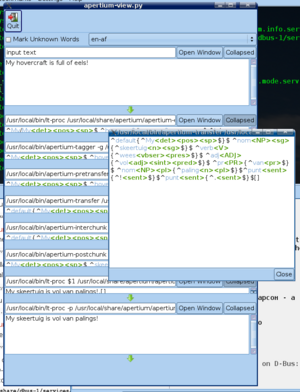Difference between revisions of "Apertium-view"
| Line 1: | Line 1: | ||
{{TOCD}} |
{{TOCD}} |
||
Apertium-view is a little program which can be used to view and edit the output of the various stages of an apertium translation. |
Apertium-view is a little program which can be used to view and edit the output of the various stages of an apertium translation. |
||
The various stages update ''while you type'', and a change made in any one pane updates the subsequent stages. |
|||
[[Image:Apertium-view-screenshot-1.png|thumb|300px|right|My hovercraft is full of eels.<br/>''Daar is palings in my skeertuig'']] |
[[Image:Apertium-view-screenshot-1.png|thumb|300px|right|My hovercraft is full of eels.<br/>''Daar is palings in my skeertuig'']] |
||
Revision as of 20:58, 12 November 2007
Apertium-view is a little program which can be used to view and edit the output of the various stages of an apertium translation.
The various stages update while you type, and a change made in any one pane updates the subsequent stages.
Currently, the program is in its early stages and it will take some time before it becomes fully usable. But if you are a developer with some knowledge of Python and PyGTK, you can already dive in.
Getting apertium-view
Check out the apertium-tools/apertium-view from the subversion repository.
Running apertium-view
Configuring apertium-view
Edit the contents of config.py to reflect you installation setup.
apertium_bin_path is the path of the directory containing the Apertium executables. apertium_dict_path is the path to directory on your computer containing all of the compiled language pairs. On my computer it's /usr/local/share/apertium. This directory contains apertium-en-af, apertium-en-ca, etc.
Executing the program
Apertium-view is very user-hostile at the moment and it won't even properly tell you what you did wrong if you pass it the wrong flags.
The format is
$ apertium-view-py <language code> <modes file path> [<mode code>]
The language code is something like en-af or en-ca. The modes path is the path to your modes XML file. The mode code is optional and refers to the name of a mode in the modes file; if you omit it, the first mode is used.
